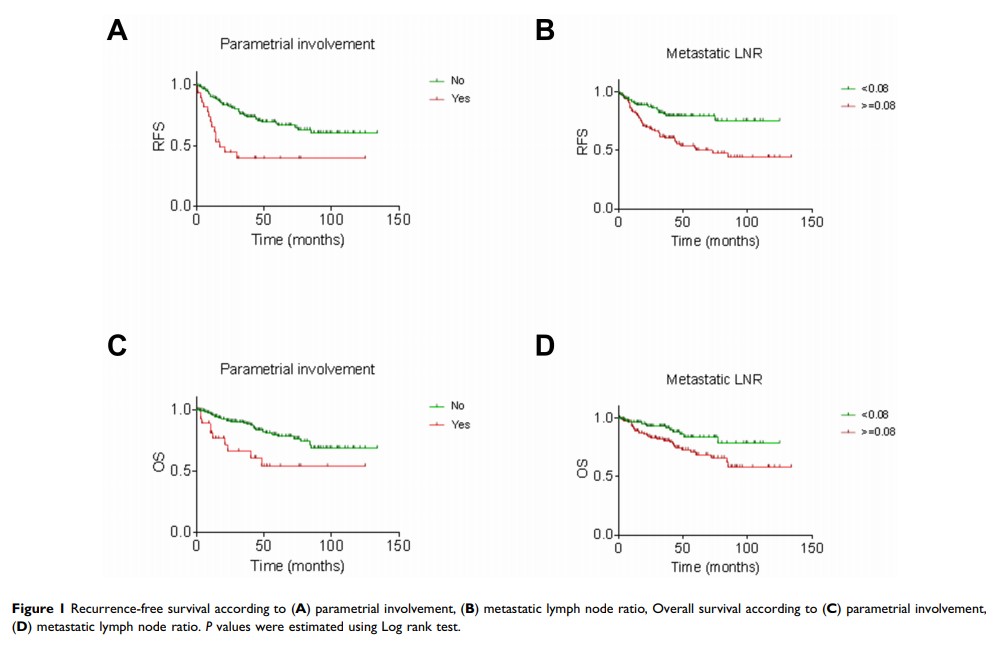108384
论文已发表
注册即可获取德孚的最新动态
IF 收录期刊
- 3.4 Breast Cancer (Dove Med Press)
- 3.2 Clin Epidemiol
- 2.6 Cancer Manag Res
- 2.9 Infect Drug Resist
- 3.7 Clin Interv Aging
- 5.1 Drug Des Dev Ther
- 3.1 Int J Chronic Obstr
- 6.6 Int J Nanomed
- 2.6 Int J Women's Health
- 2.9 Neuropsych Dis Treat
- 2.8 OncoTargets Ther
- 2.0 Patient Prefer Adher
- 2.2 Ther Clin Risk Manag
- 2.5 J Pain Res
- 3.0 Diabet Metab Synd Ob
- 3.2 Psychol Res Behav Ma
- 3.4 Nat Sci Sleep
- 1.8 Pharmgenomics Pers Med
- 2.0 Risk Manag Healthc Policy
- 4.1 J Inflamm Res
- 2.0 Int J Gen Med
- 3.4 J Hepatocell Carcinoma
- 3.0 J Asthma Allergy
- 2.2 Clin Cosmet Investig Dermatol
- 2.4 J Multidiscip Healthc

基于盆腔转移性淋巴结状况的 IIIC1p 期宫颈癌风险分层
Authors Li A, Wang L, Jiang Q, Wu W, Huang B, Zhu H
Received 19 March 2020
Accepted for publication 12 June 2020
Published 28 July 2020 Volume 2020:12 Pages 6431—6439
DOI https://doi.org/10.2147/CMAR.S253522
Checked for plagiarism Yes
Review by Single anonymous peer review
Peer reviewer comments 2
Editor who approved publication: Dr Antonella D'Anneo
Purpose: Stage IIIC1 cervical cancer showed heterogeneous in oncologic outcomes with highly variable survival rates. Our objective was to determine the prognostic significance of removed and metastatic pelvic lymph node status and further perform risk stratification in patients with stage IIIC1p cervical cancer.
Patients and Methods: Patients with stage IIIC1p cervical cancer and undergoing radical hysterectomy with lymphadenectomy in 2008– 2018 were retrospectively analyzed. Patients’ stage was classified using the revised 2018 International Federation of Gynecology and Obstetrics (FIGO) staging schema. Univariate and multivariable models were used to examine the association between removed and metastatic lymph node status and recurrence-free survival/overall survival.
Results: During a median follow-up of 34 months, 73 relapses and 44 deaths were observed among 273 patients with stage IIIC1p cervical cancer. Parametrial involvement and metastatic lymph node ratio (mLNR) were identified as independent predictors for recurrence-free survival. Parametrial involvement and mLNR were independent predictors for overall survival. A stratification system was then created based on parametrial involvement and mLNR. A total of 123 (45.1%), 127 (46.5%) and 23 (8.4%) patients were classified into the low-risk, intermediate-risk, and high-risk groups, with as a 5-year recurrence-free survival of 81.7%, 51.1%, 38%, respectively. Compared to the low-risk group, the intermediate- and high-risk groups had a significantly greater risk of recurrence and death.
Conclusion: The prognosis of stage IIIC1p patients varied significantly. A risk stratification system based on parametrial involvement and mLNR successfully separated patients into low, intermediate, and high-risk group. Our findings could facilitate the practical use of further stratification in Stage IIIC1p cervical cancer.
Keywords: cervical cancer, stage IIIC1p, pelvic lymph node, prognosis
